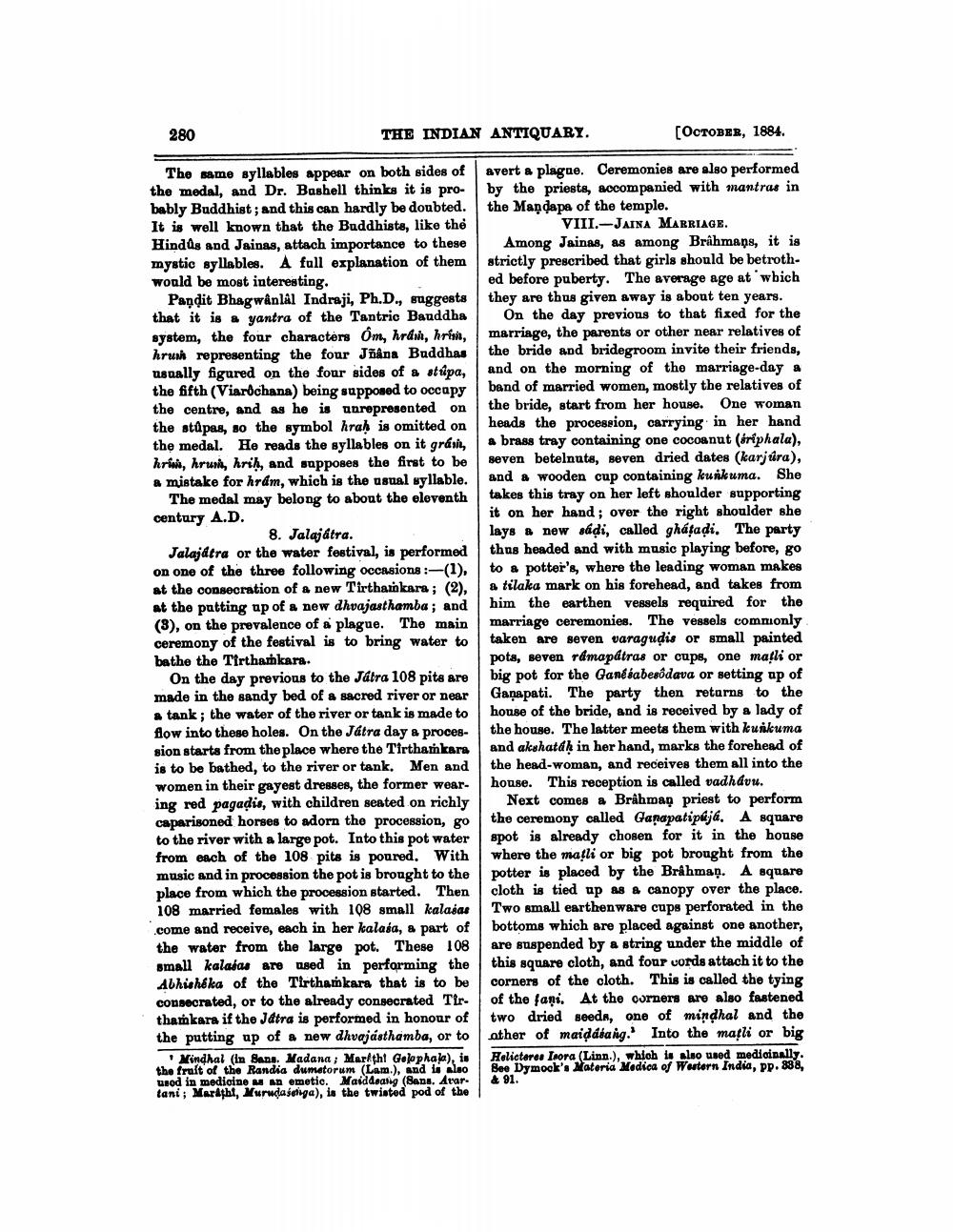________________
280
THE INDIAN ANTIQUARY.
The same syllables appear on both sides of the medal, and Dr. Bashell thinks it is probably Buddhist; and this can hardly be doubted. It is well known that the Buddhists, like the Hindus and Jainas, attach importance to these mystic syllables. A full explanation of them would be most interesting.
Pandit Bhagwanlâl Indraji, Ph.D., suggests that it is a yantra of the Tantric Bauddha system, the four characters Om, hrám, hri, hrush representing the four Jñana Buddhas usually figured on the four sides of a stúpa, the fifth (Viarochana) being supposed to occupy the centre, and as he is unrepresented on the stupas, so the symbol hrah is omitted on the medal. He reads the syllables on it grási, hri, hrum, hriḥ, and supposes the first to be a mistake for hrám, which is the usual syllable. The medal may belong to about the eleventh century A.D.
8. Jalajátra. Jalajátra or the water festival, is performed on one of the three following occasions :-(1), at the consecration of a new Tirthankara; (2), at the putting up of a new dhvajasthamba; and (3), on the prevalence of a plague. The main ceremony of the festival is to bring water to bathe the Tirthankara.
On the day previous to the Játra 108 pits are made in the sandy bed of a sacred river or near a tank; the water of the river or tank is made to flow into these holes. On the Játra day a procession starts from the place where the Tirthamkara is to be bathed, to the river or tank. Men and women in their gayest dresses, the former wearing red pagadis, with children seated on richly caparisoned horses to adorn the procession, go to the river with a large pot. Into this pot water from each of the 108 pits is poured. With music and in procession the pot is brought to the place from which the procession started. Then 108 married females with 108 small kalasas come and receive, each in her kalasa, a part of the water from the large pot. These 108 small kalasas are used in performing the Abhisheka of the Tirthamkara that is to be consecrated, or to the already consecrated Tirthamkara if the Játra is performed in honour of the putting up of a new dhvajásthamba, or to
[Остовив, 1884.
avert a plague. Ceremonies are also performed by the priests, accompanied with mantras in the Mandapa of the temple.
VIII.-JAINA MARRIAGE.
Mindhal (in Sans. Madana; Marth! Gelaphala), is the fruit of the Randia dumetorum (Lam.), and is also used in medicine as an emetic. Maiddeang (Sans. Avar. tani; Marathi, Murudasenga), is the twisted pod of the
Among Jainas, as among Brahmans, it is strictly prescribed that girls should be betrothed before puberty. The average age at which they are thus given away is about ten years.
On the day previous to that fixed for the marriage, the parents or other near relatives of the bride and bridegroom invite their friends, and on the morning of the marriage-day a band of married women, mostly the relatives of the bride, start from her house. One woman heads the procession, carrying in her hand a brass tray containing one cocoanut (ériphala), seven betelnuts, seven dried dates (karjúra), and a wooden cup containing kunkuma. She takes this tray on her left shoulder supporting it on her hand; over the right shoulder she lays a new sáḍi, called ghátadi. The party thus headed and with music playing before, go to a potter's, where the leading woman makes a tilaka mark on his forehead, and takes from him the earthen vessels required for the marriage ceremonies. The vessels commonly taken are seven varaguḍis or small painted pots, seven rámapátras or cups, one matli or big pot for the Gané sabesôdava or setting up of Ganapati. The party then returns to the house of the bride, and is received by a lady of the house. The latter meets them with kunkuma and akshatáḥ in her hand, marks the forehead of the head-woman, and receives them all into the house. This reception is called vadhávu.
Next comes a Brahman priest to perform the ceremony called Ganapatipujá. A square spot is already chosen for it in the house where the matli or big pot brought from the potter is placed by the Brâhman. A square cloth is tied up as a canopy over the place. Two small earthenware cups perforated in the bottoms which are placed against one another, are suspended by a string under the middle of this square cloth, and four cords attach it to the corners of the cloth. This is called the tying of the fani. At the corners are also fastened two dried seeds, one of mindhal and the ather of maiḍdiang.' Into the matli or big Helicteres Isora (Linn.), which is also used medicinally. Bee Dymock's Materia Medica of Western India, pp. 838,
& 91.




